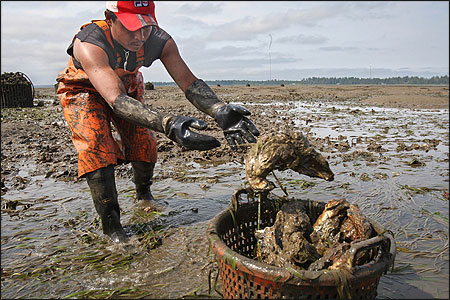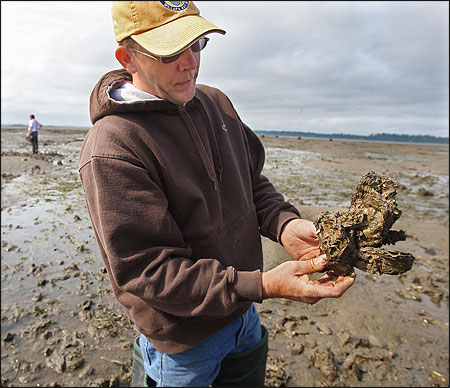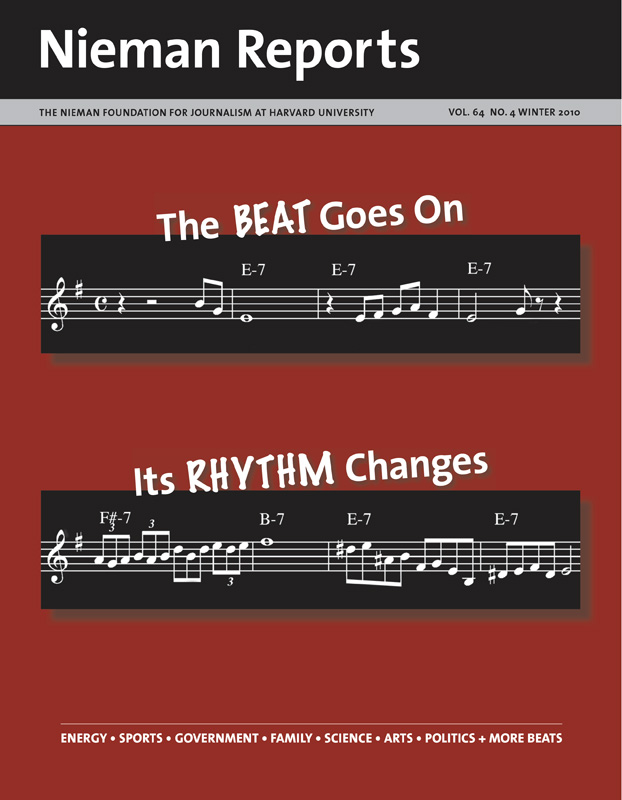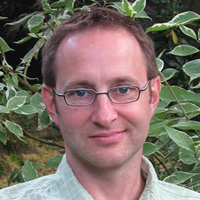
As an environment beat reporter, Craig Welch recognized the potential significance of oysters being in trouble because of changes in ocean chemistry. Their failure to reproduce is resulting in more harvesting from state preserves. Photo by Steve Ringman/The Seattle Times.
On a June morning in 2009, I stood in the mud on a Pacific Ocean beach watching a work crew gathering oysters. These shellfish had been held in reserve by the state of Washington for those odd years when wild oyster production faltered. But shellfish growers had now been forced to pluck these oysters for several straight years. That’s because the oysters in Washington state’s Willapa Bay—the heart of the West Coast’s wild oyster industry—had not reproduced in five years. I was here to understand why.
That there were problems with shellfish in the Pacific Northwest wasn’t news. Many stories had been published about the phenomenon, including a few in my own newspaper, The Seattle Times. But I had recently returned to the paper after a book leave and had been spending time on the phone catching up with sources. And the scientists I spoke with who had followed this issue suggested that new evidence pointed to a disturbing possibility. They suspected that the oysters were struggling in part because changes in ocean chemistry were affecting oyster larvae.
As The Seattle Times’s beat reporter for coverage of the environment, I recognized immediately how significant that would be. Climate scientists for years had talked about a major side effect of carbon dioxide emissions: ocean acidification. Unlike the complex science of global warming, ocean acidification is simply basic chemistry: Carbon dioxide released into the atmosphere eventually gets absorbed by the sea, and sooner or later that carbon dioxide was expected to begin making marine waters more acidic. That change, when it began, would likely have a corrosive effect on marine life—especially sea creatures with calcium carbonate shells, like oysters. Most scientists had not expected to see such changes until sometime around the year 2100. But now some of the world’s leading experts on ocean chemistry suspected the West Coast was already seeing signs of it.
It was hard to overstate how important this story could be. But telling it posed significant challenges. It was complicated, for starters, and the scientists were frank about the fact that evidence was anecdotal. In other words, they knew they could be wrong. But the implications, if they were correct, were huge. The story had to be done right.
The Gift of Time
I’ve worked on this beat at the Times for a decade. In that time I’ve learned that the hardest part of my job often isn’t getting people to talk. It’s sifting through the streaming fire hose of news to figure out which stories truly warrant more attention—and deciding how best to tell them. For that reason, covering the environment as a beat can at times feel haphazard and a bit messy. Unlike traditional beats—city hall, say, or crime—there isn’t one or even a handful of central sources of information. I don’t make morning cop calls or swing by for daily rounds at the courthouse. I rarely visit with the same people or office twice in the same week, let alone catch up with any of them every day. There is no routine.
Instead I try to keep tabs on a daunting array of issues and institutions, from the Environmental Protection Agency and the U.S. Fish and Wildlife Service to the National Marine Fisheries Service, the Forest Service, and the National Park Service. And those are just a few of the federal agencies.
None of this is to complain. I love my job and where I get to do it. My editors believe that environmental reporting is important, and this means they don’t just pay lip service to it. Even in today’s economic climate, they will put me or one of my colleagues on a plane the moment we make the case that a story matters. And while reporters at other news organizations are expected to update their blogs and Twitter feeds several times a day, at the Times we operate under a different philosophy.
When it comes to writing about the environment, the editors agree with the adage—most often attributed to the longtime and much respected Philadelphia Inquirer editor Gene Roberts—that the most important stories frequently don’t break, they ooze. In other words, the very significance of a complex story can sometimes get lost in the churning drumbeat of breaking news updates. For those stories it’s often wiser to step back and put all the pieces together.
Not that we’re allergic to breaking news. Far from it. The Times seems to have grown more nimble with age. Earlier this year the newsroom won a Pulitzer Prize for Breaking News Reporting when editors blanketed the city with reporters and photographers during a manhunt for an ex-con who had shot and killed four police officers. The staff posted video to the Web and tweeted updates into the wee hours for several days on end.
But the editors also recognize that every story is different, and environmental stories ooze more than others. That means that I, more than some, often have the luxury of time. In exchange, I feel a great responsibility to choose stories wisely and tell them fully. I want readers who might not care about the environment to at least understand why the story matters.

Third-generation shellfish farmer Brian Sheldon has turned to oysters started in hatcheries because Pacific oysters haven’t successfully reproduced in the wild since 2004. Photo by Steve Ringman/The Seattle Times.
Stories on the Beat
It’s tempting sometimes to narrow my focus, to drill down on only one or two issues. It would be so much easier to become expert only on the ecological implications of population growth or efforts to clean up Puget Sound. But the diversity of environmental stories in the Pacific Northwest is astounding, and consequently the breadth of my beat widens as the years go by.
There are ocean stories and mountain stories and international trade stories. One day I might write about the world’s most expensive environmental remediation project—the multibillion-dollar effort to clean up radioactive waste produced by the Manhattan Project at the Hanford Nuclear Reservation. Another day I’ll report on an oil spill in Alaska or the battle to clean up asbestos in a small farming community. There are fights over freshwater, needed by both the Northwest’s largest industry—agriculture—and the region’s threatened runs of Pacific salmon. There are the pollution issues—the lead and arsenic from mine tailings in communities around the West, the mercury and long-lived PCBs (polychlorinated biphenyls) now found everywhere. (One former boss called these the “parts per billion” stories.) I could write news about climate change—the politics, the economic impacts, or its ecological effects—every week.
But I feel it’s important to give readers a taste of it all, which means I have to try and keep abreast of everything. And, of course, it would be a mistake to say I actually do. I fail every day to keep on top of it all. But making the effort is what matters. Because that’s the only way that I will hear an alarm bell in my head when I’m on the phone wit
h a scientist who is talking excitedly about the minutiae of oyster larvae.
That’s how I found myself in Willapa Bay, talking to third-generation oyster growers about what was happening to their shellfish. I’d spent a few days there with a photographer and rushed back to the office to write a lengthy piece. Trusting my judgment, honed through the years of staying on this beat, my editors didn’t try to downplay the story even as I made clear that there was a lot that remained unknown. The story landed on the front page on Sunday.
This story—published in 2009—echoed around the world. I got calls from radio stations in New York, and I was interviewed by Korean television. The story seemed to strike a chord. People grasped the implications even as they understood that the science was still in flux. Some raised questions about researchers’ findings. Some questioned the way I told the story. But in the year since the piece ran, the link between ocean acidification and oyster trouble appears to have just grown stronger.
Wild oysters along Washington’s coast failed again to reproduce in 2010. Shellfish hatcheries that use water from the sea improved production by installing sophisticated water-chemistry monitors that allowed them to draw in seawater only when its acidity was normal. (The chemistry of the marine waters entering northwest estuaries shifts with wind and tidal events.) New peer-reviewed research published this fall by scientists with the National Oceanic and Atmospheric Administration suggested that ocean acidification was at least partially responsible for changes in the chemical balance of Washington’s Puget Sound.
I’ve written more stories about changing ocean chemistry. But I’m also still writing about fights over water for salmon and about the Hanford Nuclear Reservation. I find it no more appropriate to focus on just one or two issues than it ever was. There’s no telling where the next important story will come from; often it will grow out of a casual conversation about a topic I’m only beginning to understand. It’s by staying active on this beat—digging in, drilling down, widening out—that I will find these leads. That’s the only way I will know which paths are the most worthwhile to travel down.
Craig Welch, a 2007 Nieman Fellow, is the environment reporter at The Seattle Times and a two-time winner of the Society of Environmental Journalists’ top prize for beat reporting, most recently in 2010. His book “Shell Games: Rogues, Smugglers, and the Hunt for Nature’s Bounty” was published in April by HarperCollins.



